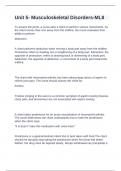Exam (elaborations)
Unit 5 Questions with complete solution
- Course
- Institution
Unit 5 Questions with complete solution To assess the joints, a nurse asks a client to perform various movements. As the client moves their arm away from the midline, the nurse evaluates their ability to perform abduction. A client performs abduction when moving a body part away from the midl...
[Show more]



